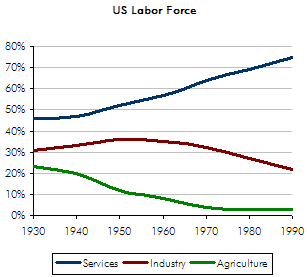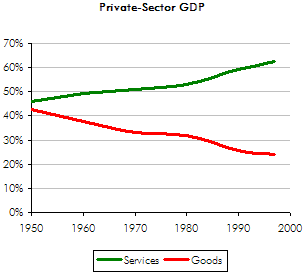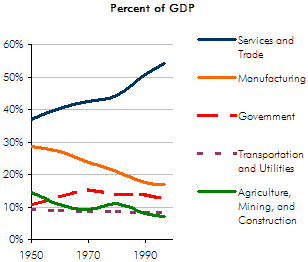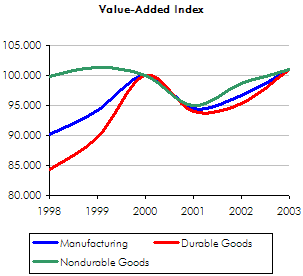Brian Gongol
Does the United States make anything anymore? Yes. But the trend is definitely in favor of the service sector of the economy, rather than the industrial side.
To hear labor activists and anti-trade protesters talk about it, one might think America's "industrial decline" is a recent phenomenon. But the truth is quite different.
|
Myth #1: A Large Number of American Workers Work in Factories
Quite to the contrary. More Americans have worked in the service sector since the 1930s and earlier. Current fissures in the organized-labor movement (as the Teamsters threaten to leave the AFL-CIO and rival unions now solicit members to switch unions) reflect the significant difference between entrenched interests' belief in the influence they can wield and the mainline workers' realization that the organized-labor movement exists in a very different environment from the one in which it was founded. Conventional factory employment, while not entirely a thing of the past, is significantly less common among workers and less important to the overall economy. Quite simply, the workers aren't there in sufficient numbers to leverage much power. |

Sources: US Census: "Employment Status of the Civilian Population: 1929 to 2002" and US Census: "Nonfarm Establishments — Employees, Hours, and Earnings by Industry: 1919 to 2002" |
|
Myth #2: America's Economy is Driven By Manufacturing
Again, not quite. Services have contributed more to the private-sector's share of the economy than goods since the 1950s. (As an aside, it should be noted that despite ever-rising taxes, the government's contribution of added value to GDP remained relatively flat in the 11% to 15% range throughout the second half of the 20th Century.) Two-thirds of the economy is generated in the service sector. |

Source: Bureau of Economic Analysis |
|
Myth #3: Free Trade Agreements Have Killed the Manufacturing Economy
Free trade agreements have certainly caused some industries to move offshore, but it's not a recent phenomenon. Services and trade have grown consistently since the 1950s, while both industry and agriculture have declined. Government and transportation have contributed roughly the same amount to GDP over time. What free trade does is re-arrange the distribution of industrial production. The United States, in general, will have better-educated and higher-skilled workers than other countries with less advanced economies. Consequently, the US should have an advantage in manufacturing that requires skilled labor, and a disadvantage in low-skill sectors. While every job loss is unfortunate inasmuch as it causes pain for the unemployed worker and his or her family, the best thing to do is not to protest the trade that led to the job loss, but to use the benefits of that trade (including a growing economy) to re-train the worker for a higher-skill job elsewhere in the economy. There's absolutely no getting around the fact that the United States has far fewer farmers than it did a century ago, yet total agricultural output is vastly greater than it was when we had more farm laborers. The same trend has taken hold of the manufacturing sector. Production has increased, even as overall employment has decreased. |

Source: Bureau of Economic Analysis |
|
Myth #4: The United States Doesn't Make Anything Anymore
This analysis originated with a suggestion from economist Dr. David Tufte, who noted the misperception that the United States doesn't produce much anymore. Clearly untrue. Even on the micro (year-to-year) scale, there has been no massive decline in overall industrial output. Quite simply, anyone who thinks the United States doesn't make anything "anymore" must have held that position over a matter of decades, since there has been no massive decline in the last six years. |

Source: Bureau of Economic Analysis |
The data here generally ceases at 1997 due to changes in the government's methods of recording and reporting this data. The long-term trends, however, are clear: Industrial production, while still a large component of both employment and total GDP in the United States, is not the most important sector of the economy, nor has it grown in any relative measure since the 1950s.
